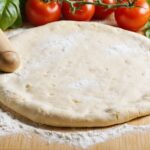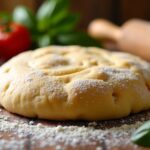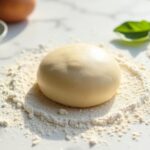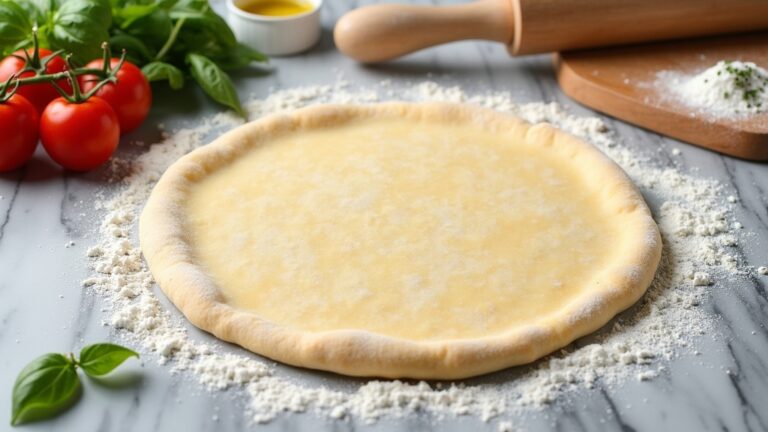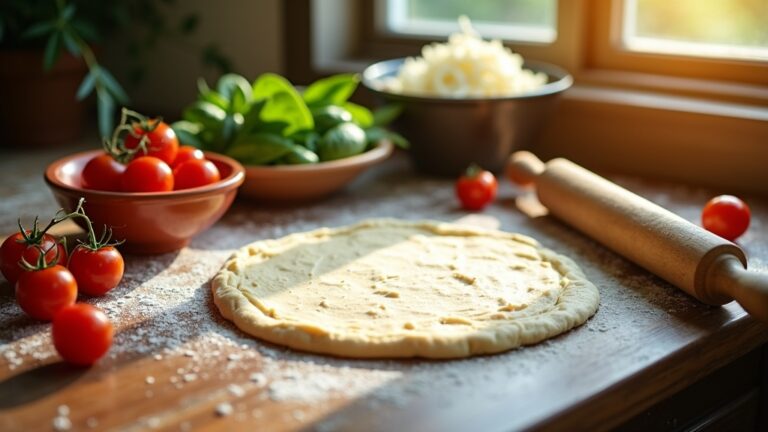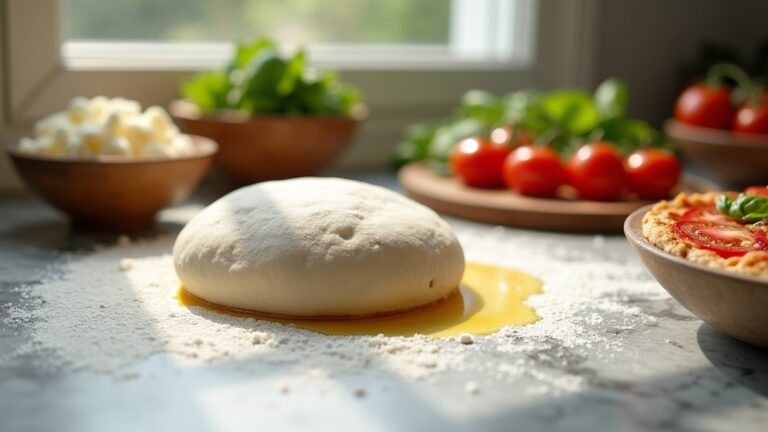Pizza Dough Recipe Bread Machine
Making pizza dough in a bread machine is simple and rewarding! I mix 2 ¼ teaspoons of active dry yeast with 1 ½ cups of warm water, then add 3 ½ to 4 cups of all-purpose flour, 1 tablespoon of sugar, 2 teaspoons of salt, and 2 tablespoons of olive oil. The bread machine does the kneading and rising. I love how easy it makes crafting a fresh, delicious crust. Stick around, and I’ll share more tips and tricks!
Contents
History
When I think about the history of pizza dough, I can’t help but imagine the bustling streets of Naples in the late 18th century, where the dish first began to take shape. Its ancient origins trace back to flatbreads enjoyed by various cultures, but it was in Naples that the concept evolved into the beloved pizza we recognize today. As the dough was perfected, regional variations emerged, each reflecting local ingredients and culinary traditions. From the classic Margherita to the adventurous toppings of today, pizza dough has transformed through time, adapting to modern tastes while honoring its rich heritage. This blend of history and innovation makes pizza a culinary canvas, inviting us to explore and create our own delicious variations.
Recipe
Making pizza dough at home is a rewarding and enjoyable experience that can elevate your pizza-making skills to a new level. With just a few simple ingredients, you can create a delicious, homemade crust that serves as the perfect foundation for your favorite toppings. Whether you prefer a thin and crispy crust or a thick and chewy one, this versatile dough recipe can be easily adapted to your preferences.
To get started, you’ll need to gather your ingredients and allow yourself some time for the dough to rise. This process not only enhances the flavor but also gives the dough a wonderful texture. Once you have the dough prepared, you’ll be ready to roll it out and create your very own pizza masterpiece, right from the comfort of your kitchen.
Ingredients:
- 2 ¼ teaspoons active dry yeast
- 1 ½ cups warm water (about 110°F)
- 3 ½ to 4 cups all-purpose flour
- 1 tablespoon sugar
- 2 teaspoons salt
- 2 tablespoons olive oil
Instructions:
In a large mixing bowl, dissolve the yeast and sugar in the warm water and let it sit for about 5-10 minutes until foamy. Once activated, stir in 2 cups of flour, salt, and olive oil until combined. Gradually add the remaining flour, ½ cup at a time, until a soft dough forms. Knead the dough on a floured surface for about 5-7 minutes until smooth and elastic. Place the dough in a lightly oiled bowl, cover it with a clean cloth, and let it rise in a warm place for about 1 to 1.5 hours or until it has doubled in size.
Extra Tips:
For the best results, be sure to use warm water to activate the yeast, as water that is too hot can kill it. If you’re short on time, you can let the dough rise in a warm oven (turned off) for a faster rise. Additionally, feel free to experiment with different types of flour, such as bread flour for a chewier texture or whole wheat flour for a healthier alternative. And don’t forget to preheat your oven before baking your pizza to achieve that perfect crispy crust!
Cooking Steps
Let’s get started with the cooking steps that will turn your ingredients into delicious pizza dough. First, I always add warm water to the bowl, followed by the yeast to get things bubbling. From there, we’ll gradually mix in the flour, kneading the dough until it’s smooth and ready to rise!
Step 1. Add Warm Water First
To achieve the perfect pizza dough, adding warm water is essential; it activates the yeast and helps create that delightful rise. When I pour in the warm water first, I can already feel the magic begin. The warm water benefits are twofold: it not only wakes up the yeast but also promotes a smooth, cohesive dough consistency. I find that this step sets the foundation for a light, airy crust that’s both chewy and crispy. As the water mingles with the flour, I can see the ingredients starting to come together, forming a velvety texture. This simple yet vital addition transforms my dough, ensuring that every bite of my pizza is a delicious experience.
Step 2. Add Yeast Next
Sprinkling the yeast into the warm water feels like adding the final ingredient to a secret potion. I watch as the tiny granules dissolve, setting the stage for yeast activation. It’s fascinating to think about the different types of yeast—active dry, instant, or fresh—each playing a unique role in the dough’s rise. I give it a gentle stir, ensuring every bit is engaged with the water. As I let it rest for about five minutes, I can almost feel the excitement bubbling beneath the surface. This step is essential; it’s where the magic begins. The yeast will wake up, multiply, and create those delightful air pockets that make the crust airy and chewy. This is where innovation happens, and I can’t wait to see the results!
Step 3. Add Flour Gradually
As the yeast mixture starts to bubble with life, I gradually incorporate the flour, allowing the dough to take shape. This step is all about precision and patience. I prefer a mix of flour types to achieve that perfect texture. Here’s how I do it:
- All-Purpose Flour: For a balanced base that’s versatile and reliable.
- Bread Flour: To enhance elasticity, giving my crust that delightful chew.
- Semolina Flour: Just a sprinkle, adding a subtle nuttiness and a slightly gritty texture.
- Whole Wheat Flour: For a hint of earthiness and added nutrients.
With each gradual addition, I watch the dough transform, enthusiastic for the next step in my pizza-making journey.
Step 4. Knead Dough for 10 Minutes
Kneading the dough is where the magic really begins. As I press and fold the mixture, I can feel it transforming under my hands. I aim for that perfect dough consistency—smooth, elastic, and just a tad tacky. Using various kneading techniques, like the classic stretch and fold or the push and turn, I guarantee every bit of flour is integrated. I dedicate a full ten minutes to this process, feeling the dough come alive with each motion. It’s fascinating how the gluten develops, creating that ideal structure for my pizza. I keep my eyes on the texture; it should bounce back slightly when pressed. This step is essential for achieving the perfect crust when it’s time to bake!
Step 5. Let Dough Rise for 30 Minutes
After kneading the dough to perfection, it’s time for the next significant step: letting it rise for 30 minutes. This rising time is essential for achieving that ideal dough texture, transforming it from dense to delightfully airy. Here’s how I make the most of this phase:
- Cover the bowl with a damp cloth to trap warmth and moisture.
- Set it in a warm spot, like near a sunny window or on top of the fridge, where the yeast can thrive.
- Check the dough after 30 minutes; it should have doubled in size, puffing up with promise.
- Gently press it down to release any air bubbles, keeping that perfect texture for shaping your pizza. Enjoy the magic of rising!
Nutritional Guide
When I think about making pizza dough, I can’t help but consider its nutritional aspects, which can greatly influence our meal choices. Understanding the calorie count and ingredient benefits helps me create a healthier pizza experience. Here’s a helpful table that breaks down some common ingredients:
| Ingredient | Calorie Count (per 100g) | Ingredient Benefits |
|---|---|---|
| All-Purpose Flour | 364 | Provides carbohydrates for energy |
| Olive Oil | 884 | Healthy fats that support heart health |
| Yeast | 325 | Aids digestion and boosts immunity |
| Sugar | 387 | Quick energy source, enhances flavor |
Final Thoughts
Understanding the nutritional aspects of pizza dough not only enhances our meal choices but also empowers us to enjoy our favorite dishes with greater awareness. As I experiment with various pizza variations, I’ve discovered that a few baking tips can elevate my creations:
- Use high-protein flour for a chewier crust.
- Let the dough rise longer to develop flavor and texture.
- Preheat your baking surface to achieve that perfect crispy base.
- Experiment with toppings like fresh herbs or unique cheeses for a gourmet twist.
Frequently Asked Questions
Can I Use Whole Wheat Flour Instead of All-Purpose Flour?
Absolutely, I’ve swapped all-purpose flour for whole wheat before. The texture changes, becoming denser, but the health benefits are worth it. It adds a nutty flavor and more nutrients—perfect for a wholesome twist in baking!
How Long Can I Store Pizza Dough in the Fridge?
I’ve found that pizza dough storage in the refrigerator lasts about three to five days. For best results, I suggest wrapping it tightly in plastic to prevent drying out. Those refrigerator tips really make a difference!
Can I Freeze Pizza Dough for Later Use?
Absolutely, I freeze pizza dough for later use! I use proper freezing techniques, like wrapping it tightly in plastic wrap. This guarantees ideal dough storage, preserving its flavor and texture for delicious future pizzas.
What Type of Yeast Is Best for Pizza Dough?
When I make pizza dough, I always choose instant yeast for its convenience and quick rise. However, active dry yeast works beautifully too; it just requires a bit more time to activate. Both yield delicious results!
How Can I Make Gluten-Free Pizza Dough?
To craft a gluten-free pizza dough, I blend innovative gluten-free flours like almond and tapioca. While they may not rise as traditional doughs, the texture still delivers a delightful, satisfying bite that’s worth trying!
Conclusion
As I pull the golden-brown pizza crust from the oven, the aroma dances through the air, a fragrant reminder of the joy that comes from homemade goodness. I can’t help but imagine the laughter shared over a slice, the vibrant toppings sparkling like jewels atop a warm canvas. This dough recipe isn’t just a method; it’s a gateway to memories, a delicious tapestry woven together with love and creativity, inviting you to savor every bite and create your own stories.


